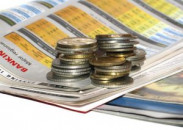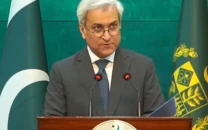SBP leaves policy rate on hold
Maintains status quo to keep cost of borrowing at lower level, push growth

In line with market expectations, Pakistan’s central bank on Tuesday left the benchmark interest rate unchanged at 7% for the next two months to keep the cost of borrowing from banks at a low level and let the economy grow by 4-5% in the current fiscal year.
It was the sixth consecutive bi-monthly monetary policy statement (MPS) in which the State Bank of Pakistan (SBP) maintained the policy rate to support recovery in economic activities to pre-Covid levels despite a higher inflation reading and recent depreciation of the rupee..
The inflation rate, however, dropped to 8.9% in FY21 compared to 10.74% in FY20.
“Inflation (at the current level) is still high,” SBP Governor Reza Baqir said while announcing the monetary policy at an online press conference on Tuesday.
The benchmark interest rate is a tool available with central banks around the world to curb inflation and control exchange rate.
The governor, however, found the current inflation reading high largely due to short supply of food items (like wheat flour, sugar and cooking oil) and soaring international petroleum oil prices as the country heavily relies on imported energy. “The non-food and non-energy inflation remains under control.”
He said that the central bank would gradually increase the benchmark interest rate once it was certain that inflation was surging mainly due to a pickup in demand for commodities and products and the economy had recovered to pre-pandemic levels.
The gradual rise, when needed in future, would bring the real interest rate (the benchmark interest rate minus inflation rate) back to the positive territory from the negative 2-3% at present.
Pakistan’s current account deficit may widen moderately to 2-3% of gross domestic product (GDP), which was sustainable, amid rising imports in the current fiscal year - FY22. The deficit stood at 0.6% of GDP (or $1.8 billion) in FY21.
He said that the widening deficit would lend support to Pakistan for achieving 4-5% economic growth. The country recorded a growth rate of 4% in FY21 against the negative growth of 0.5% in FY20.
“With a contained current account deficit and healthy commercial, official, portfolio and foreign inflows, Pakistan’s external financing needs of around $20 billion are expected to be more than fully met in FY22.”
In August, “Pakistan’s (foreign exchange) reserve buffers are expected to rise by another $2.8 billion through the IMF’s planned new global SDR (IMF currency) allocation.”
The SBP’s foreign exchange reserves rose by $5.2 billion to over $17 billion in FY21, covering around three months of imports and touching a 4.5-year high.
Moreover, the SBP’s net external reserve buffers (gross reserves less forward liabilities) have risen by $14.1 billion since the beginning of FY20.
Besides, overseas Pakistanis have deposited a significant amount of $1.8 billion in Pakistani banks through the Roshan Digital Account (RDA) during the first 10 months or since the government and SBP launched the RDA-routed investment options for non-resident Pakistanis in September 2020. Foreign currencies’ inflows on account of worker remittances and exports would continue to grow in FY22 as they hit an all-time high in FY21, Baqir said.
The central bank would soon unveil a bank financing scheme for small and medium-sized enterprises (SMEs) to ensure that bank credit was also availed by the small and medium-sized businesses and all the financing was not provided to big businesses only, he said.
“The scheme will allow SMEs to borrow from banks (and other financial institutions) without submitting any collateral. The central bank will provide limited guarantees to share some risk. This will ensure the growth of SMEs and the economy at large,” he said. He announced that resident Pakistanis would be allowed to open and operate accounts in banks across the country through online facilities and without physically visiting the bank branches.
Earlier, the government had approved this facility for the overseas Pakistanis under the RDA.
He said that the government and central bank resolve to keep supporting construction and allied industries through fiscal incentives and increased bank financing would aid the country achieve the desired economic growth of 4-5% in FY22.
The central bank projected average inflation in the range of 7-9% this fiscal year. Imports are expected to grow on the back of economic recovery and rebound in global commodity prices.
“Imports are projected to be more skewed towards machinery rather than consumption compared to FY17, and machinery imports are projected to be better distributed across sectors than in FY18, when power and telecommunications dominated.”
The growth is expected to pick up further, supported by measures announced in the budget for FY22, accommodative monetary conditions, and disbursements under the SBP’s TERF for investment and other refinance facilities.
Key budgetary measures include increased development spending and reduced regulatory duties, customs duties, federal excise duty and sales tax on the import of raw material and capital goods. These measures will directly benefit construction and allied industries, as well as export-oriented and import-substitution industries.
Published in The Express Tribune, July 28th, 2021.
Like Business on Facebook, follow @TribuneBiz on Twitter to stay informed and join in the conversation.



















COMMENTS
Comments are moderated and generally will be posted if they are on-topic and not abusive.
For more information, please see our Comments FAQ